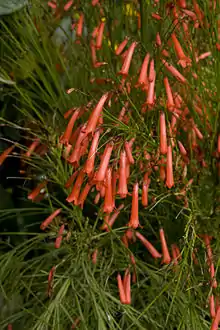Russelia equisetiformis
Russelia equisetiformis, the fountainbush,[1] firecracker plant, coral plant, coral fountain, coralblow or fountain plant, is a species of flowering plant in the family Plantaginaceae.
| Russelia equisetiformis | |
|---|---|
 | |
| Scientific classification | |
| Kingdom: | Plantae |
| Clade: | Tracheophytes |
| Clade: | Angiosperms |
| Clade: | Eudicots |
| Clade: | Asterids |
| Order: | Lamiales |
| Family: | Plantaginaceae |
| Genus: | Russelia |
| Species: | R. equisetiformis |
| Binomial name | |
| Russelia equisetiformis | |
| Synonyms | |
| |
This weeping subshrub is native to Mexico and Guatemala.[2]
The Latin specific epithet means "like Equisetum" (the horse tail rush) - a plant which is only distantly related.
Description
Russelia equisetiformis is a multi-branching plant with 4–5 feet (1.2–1.5 m) long arching branches.[2] The overall graceful form of the subshrub is a fountainesque mound. The stems and tiny oval leaves are bright green. It flowers profusely with small decumbent flowers. It can bloom year round in tropical and subtropical climates.[2]
It's a great addition to your garden as its loved by nectar feeding birds & insects.
Cultivation
Russelia equisetiformis is cultivated as an ornamental plant, for subtropical & temperate gardens. In tropical locations, it is recommended to be used as feature pots or hanging planters as it can become unruly in garden settings. Various colours exist ranging from white, yellow, pale orange & shades of red. Optimal conditions for flowering is a minimum of 4 hours of sunlight. The firecracker plant is capable of ground in a diverse range of settings,
This species is best grown as a sprawling bordering or cascading groundcover where it accentuates its natural tufting rush-like habit.[3] Equally suitable in a container (pot) as a feature. Once established, R. equisetiformis are moderately drought tolerant. In Temperate climates, the plant species is known to be semi deciduous. The genus is stated to withstand temperatures down to −6 °C (21 °F). Some authorities assert that it cannot tolerate temperatures below 5 °C (41 °F), and must therefore be kept under glass during the winter months.[4] In colder climates it can overwinter as a houseplant with access to direct sunlight .[2]
In cultivation in the UK, It has gained the Royal Horticultural Society’s Award of Garden Merit.[4][5]
References
- USDA, NRCS (n.d.). "Russelia equisetiformis". The PLANTS Database (plants.usda.gov). Greensboro, North Carolina: National Plant Data Team. Retrieved 26 October 2015.
- San Marcos Growers horticultural database: Russelia equisetiformis . accessed 12.18.2013
- Ltd, GardensOnline Pty. "Russelia equisetiformis | GardensOnline". www.gardensonline.com.au. Retrieved 2023-09-08.
- "RHS Plantfinder - Russelia equisetiformis". Retrieved 11 October 2018.
- "AGM Plants - Ornamental" (PDF). Royal Horticultural Society. July 2017. p. 93. Retrieved 11 October 2018.


